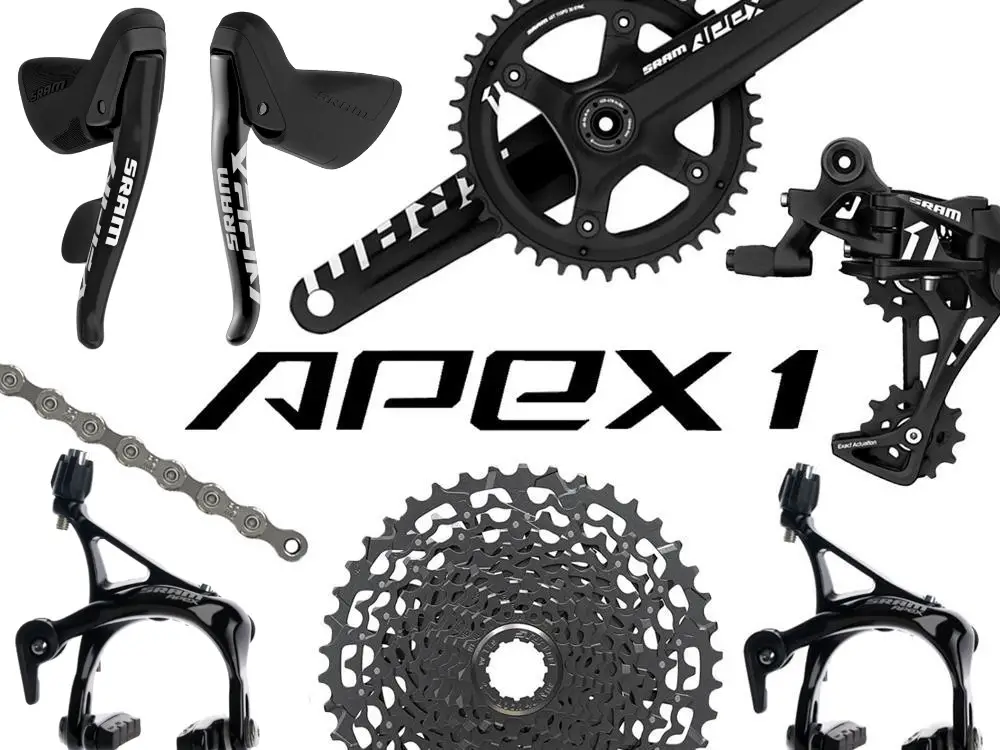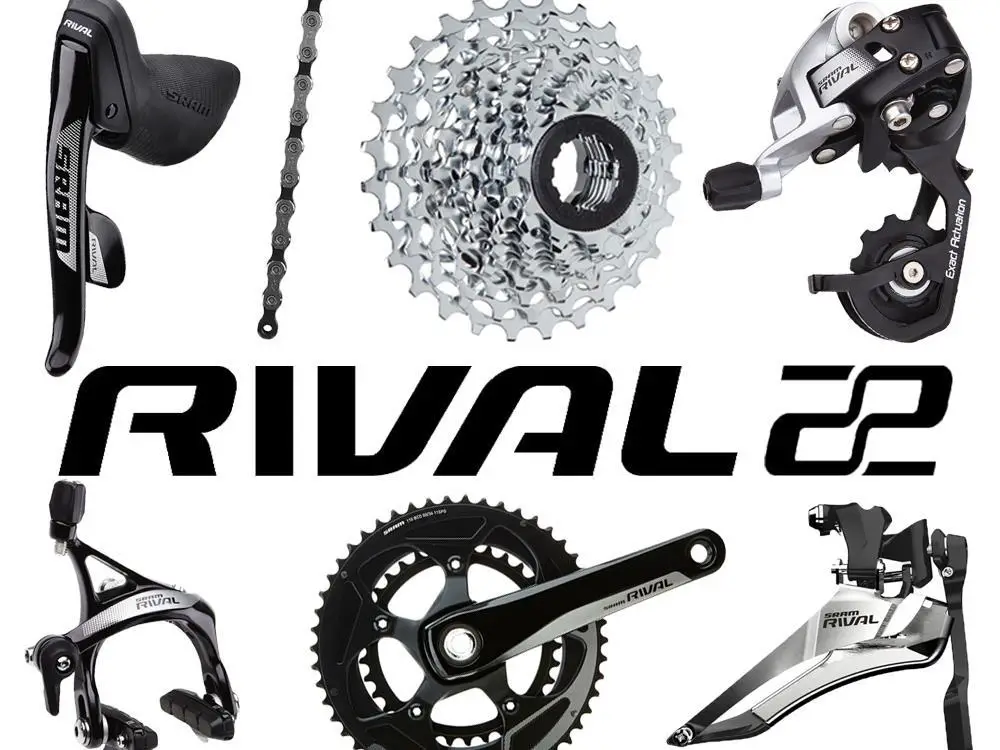On top of the list of the best performing groupset brands is SRAM, alongside Campagnolo and Shimano. Recently, SRAM introduced Apex 1, which is a single chainring version of its entry-level groupset.
Apex 1 closely compares to the SRAM Rival model, as they are both paired with wide-ranging cassettes. This guide is a detailed comparison of both to help you know what to expect from each.
Contents
All About SRAM Apex 1

SRAM Apex 1 groupset is designed to offer you guaranteed performance across its broad range of 11-32t sprockets.
When it first came into the market in late 2010, it marked the beginning of a gearing revolution. For the first time in the history of road bikes, you can fit cassettes with up to 32 teeth on the biggest sprocket.
An old-school racing cyclist may not see the importance of a few more teeth. However, for you, this spells all the difference in being able to enjoy your road bike on challenging routes.
The bigger sprocket lets you spin uphill with a lot more ease. Apex offers a wide range of gears than most triple chainsets do, without the extra weight. While it may have lost its USP, Apex has not lost its charm.
The initial selling point of SRAM Apex 1 is its compatibility with up to 32t rear sprockets. The groupset relies on WiFLi (Wider, faster, Lighter) technology that attracts most users.
It also has a notable difference between it and the rest of the range. This is its 10-speed groupset that makes the jumps between gears more noticeable.
Tip-Top Double Tapping
Apex 1 comes with DoubleTap shifters for which users have developed a preference. They’re difficult to deal with for users too familiar with the Shimano or Campagnolo gear change systems.
The DoubleTap brake lever doesn’t pivot sideways and provides for controlled gear selection. Clicking on the paddle to drop the chai down doesn’t take a lot of effort. The system provides for a smooth operation. Once you get used to everything from the paddle sweep to the feel of the brake hoods, everything feels assured.
Chainset
The groupset comes with a wider-ranging rear mech. However, the derailleurs still perform exceptionally well on the bike.
Its performance feels very refined and delivers a slightly utilitarian feel about the groupset. However, that is partly because of the type of bike in question.
The front derailleur offers quick and accurate shifts and hence very reliable. The Apex chainset is compact, with chainrings of 50/34, 53/39, and 48/35 teeth, which the market finds to be the perfect match.
One Less Sprocket
One downside of Apex is that while its competitors offer cassettes with 11 sprockets, Apex is only 10-speed.
The brakes are also still resolutely mechanical, yet the competitors provide hydraulic brakes. However, SRAM provides the after-market S-700 Hydraulic brake system compatible with 10-speed systems.
However, the braking system is still superb and reasonably long drop. This allows you enough room to squeeze in a mudguard for winter use.
Who Should Invest in SRAM Apex 1?
SRAM Apex is an excellent option for anyone who wants to have a reliable and value-based performance. One push of the single paddle behind the brake lever is enough to shift the chain up or down.
The Apex 1 is suitable for use by commuters, roadies, gravel adventure cyclists, and cyclocross racers, on-road and off-road.
SRAM Apex 1 Pros
- The gears are well spread out
- The groupset is relatively light
- Affordable
- Decent mechanical rim brakes
- Suitable for various drop-bar cycling disciplines
SRAM Apex 1 Cons
- Only compatible with 10-speed
- Double-tap is not ideal for lowest-gear cycling
Final thoughts on SRAM Apex 1
SRAM Apex is a decent alternative to Shimano and Campagnolo, but it has several weaknesses compared to its rivals. Overall, it comes as an all-round groupset with excellent brake performance.
The trade-off between refinement and dependability is fair, not forgetting the forgiving gear ratios. While it may not perform as well as some other groupsets on the market, it gives you what you pay for.
All About SRAM Rival Groupset

The SRAM Rival groupset is slightly above the Apex in several ways. While they both use the WiFLi technology in the rear derailleur and case system, Rival is lighter. This makes it more popular in the SRAM range for road bikers.
Rival comes as an 11-speed groupset and has a more popular 2 x 11 chainring set up. However, you can also get it with only one chainring of 1 x 11.
As a more recent SRAM creation, Rival has more modern features based on more recent technology. Its DoubleTap levers are more revamped, and the shift paddles are also bigger.
Some common features between Rival and Apex include 22 gear options for hydraulic brakes. It also features a shift/brake lever with a comfortable ErgoFit design. However, unlike other groupsets in its class, Rival is heavier as it comes with aluminum materials instead of carbon.
Front and Rear Derailleurs
Depending on the Rival version you choose, the rear derailleurs provide several varieties. The rear derailleurs (2x) in the short- models are best for close-ratio cassettes.
The mid-cage lengths are designed for compatibility with wide-ratio cases. The 1x rear derailleur features a clutch and straight parallelogram not compatible with front derailleurs.
The front derailleur that SRAM calls Yaw acquires a new angle as it moves inward and outward. This reduces sudden stops and makes the front shifting easier and faster. One push is all you need for the big ring, and another push to return to the small one.
Hydraulic and Rim Brakes
Rival incorporates disc brakes available for both post-mount and flat-mount style frames. The calipers have a design that looks like a dual-piston like most hydraulic braking systems.
The brake system uses DOT hydraulic fluid, which you should flush routinely to prevent it from degrading.
The rim brakes are traditional, have a dual-pivot make, and center bolted. Recently, SRAM introduced a rim brake that you can directly mount on your bike and which works well with Rival’s controls.
Rival Shifters
The DoubleTap shifters are best for 1x and 2x drivetrains. They are compatible with both hydraulic and cable-based brakes.
They allow you to shift with a single paddle located behind the brake lever. For Rival components with flat handlebars, SRAM makes an 11-speed shifter for enhanced compatibility.
Who Should Invest in SRAM Rival?
The rear shifting provided by the Rival groupset is fast and reliable. While most shifts happen effortlessly, they are occasionally sluggish and unrefined.
This is common with the higher gears or smaller cogs. The wide-range 1x cases are slower shifting than the close-ratio cassettes.
These factors make them ideal for cyclists with decent modulation and riding power. Its front and rear shifting capabilities are precise and quiet.
The Rival hoods are small and make it easy for users with small hands to wrap their fingers around the hood.
SRAM Rival Pros
- Provides solid performance across the board
- The braking system is better compared to rivals
- Provides more gear options
- Simple to use
- Ergonomically designed levels
SRAM Rival Cons
- Lacks remote shifting
- Expensive
Final Thoughts on SRAM Rival
The Rival groupset comes with two braking systems that make it stand out from the competition. This makes it more compatible with a wide range of bikes.
It also provides for a comfortable ride with a high and precise level of speed control.
As a mid-range groupset, the shifting is far superior to others in its range. It's also a lot sharper and faster. However, Rival is a little uncomfortable in performance.
Final Thoughts: Choosing Between SRAM Apex and SRAM Rival
Both Rival and Apex perform well on the road. They don't have many differences between them in terms of weight and performance.
Although Rival is a little uncomfortable, it has a higher precision level and better speed control. In pricing, Rival requires a little more costly investment than Apex, but the difference is not huge.
Apex is an excellent choice for users looking for reliable performance and great value. Rival is a better choice among the mid-range groupsets.
It provides outstanding performance across the board, especially for long cycles.

